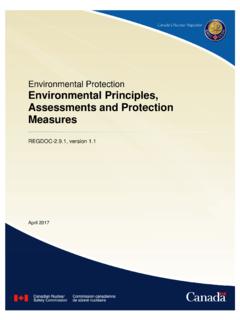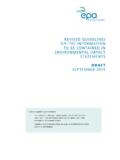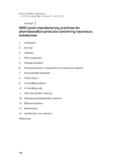Transcription of ENVIRONMENTAL MANAGEMENT FOR MALARIA …
1 ENVIRONMENTAL MANAGEMENT FOR MALARIA control IN THE EAST ASIA AND PACIFIC (EAP) REGION Steve Lindsay, Matthew Kirby, Enis Baris and Robert Bos April 2004ii Health, Nutrition and Population (HNP) Discussion Paper This series is produced by the Health, Nutrition, and Population Family (HNP) of the World Bank's Human Development Network (HNP Discussion Paper). The papers in this series aim to provide a vehicle for publishing preliminary and unpolished results on HNP topics to encourage discussion and debate.
2 The findings, interpretations, and conclusions expressed in this paper are entirely those of the author(s) and should not be attributed in any manner to the World Bank, to its affiliated organizations or to members of its Board of Executive Directors or the countries they represent. Citation and the use of material presented in this series should take into account this provisional character. For free copies of papers in this series please contact the individual authors whose name appears on the paper.
3 Enquiries about the series and submissions should be made directly to the Editor in Chief. Submissions should have been previously reviewed and cleared by the sponsoring department, which will bear the cost of publication. No additional reviews will be undertaken after submission. The sponsoring department and authors bear full responsibility for the quality of the technical contents and presentation of material in the series. Since the material will be published as presented, authors should submit an electronic copy in a predefined format as well as three camera-ready hard copies (copied front to back exactly as the author would like the final publication to appear).
4 Rough drafts that do not meet minimum presentational standards may be returned to authors for more work before being accepted. The Editor in Chief of the series is Alexander S. Preker For information regarding this and other World Bank publications, please contact the HNP Advisory Services at: Tel (202) 473-2256; and Fax (202) 522-3234. ISBN 1-932126-90-2 2004 The International Bank for Reconstruction and Development / The World Bank 1818 H Street, NW Washington, DC 20433 All rights Health, Nutrition and Population (HNP) Discussion Paper ENVIRONMENTAL MANAGEMENT for MALARIA control in the East Asia and Pacific (EAP)
5 Region Steve Lindsaya, Matthew Kirbyb, Enis Barisc and Robert Bosd aProfessor, School of Biological and Biomedical Sciences, University of Durham, Durham, United Kingdom bMedical Entomologist, School of Biological and Biomedical Sciences, University of Durham, Durham, United Kingdom cSenior Public Health Specialist, ECSHD, the World Bank, Washington DC, USA dScientist, Water, Sanitation and Health Unit, Protection of the Human Environment, World Health Organization (WHO), Geneva, Switzerland Paper prepared as part of a series of studies on communicable diseases in East Asia and the Pacific, Washington, 2003 Abstract: MALARIA attacks millions in the East Asia and Pacific (EAP) region, and greatly impedes economic development, particularly affecting the rural poor.
6 In the early 1900s MALARIA was controlled in many parts of the region using ENVIRONMENTAL MANAGEMENT (EM) for vector control . EM is where the environment is modified or manipulated to reduce MALARIA transmission by attacking local vector mosquitoes and requires an understanding of the ecology of these species. Today MALARIA control is based on drugs and insecticides, but their sustainability has been undermined by the development of resistance and growing concerns about the long-term ENVIRONMENTAL impact of some insecticides.
7 EM would strengthen MALARIA control activities and be cost-effective. To be successful EM requires co-ordination and collaboration between different public sectors. This document presents the options that exist to minimize MALARIA risks associated with infrastructure development projects. It also aims to raise awareness of the wide array of opportunities that exist to design, construct and operate infrastructure as a sustainable means of reducing MALARIA transmission risks in specific settings.
8 We make three major recommendations. Firstly, health impact assessments should be part of the planning process of all infrastructure projects, in order to identify, qualify and possibly quantify adverse health effects at the earliest possible stage and suggest remedies. Secondly, design and installation of infrastructure works that modify the environment or support ENVIRONMENTAL manipulation activities should become a significant part of MALARIA interventions in the EAP Region. The utility and cost-effectiveness of such interventions need to be researched and confirmed.
9 Thirdly, in order to build an enhanced capacity for multidisciplinary research, there is a need to invest in training at a variety of levels. ENVIRONMENTAL MANAGEMENT offers exciting new opportunities for sustainable MALARIA control throughout the EAP, not on it s own, but as part of an integrated approach to MALARIA MANAGEMENT . Keywords: ENVIRONMENTAL MANAGEMENT , MALARIA , vector control , East Asia and Pacific Region Disclaimer: The findings, interpretations and conclusions expressed in the paper are entirely those of the authors, and do not represent the views of the World Bank, its Executive Directors, or the countries they represent.
10 Correspondence Details: Enis Baris, the World Bank 1818 H Street NW, Mail Stop H7-700, Washington DC 20433; Tel: (202) 458-4474; Fax: (202) 614-0947; Email: iv v Table of Contents ABOUT THE EXECUTIVE MALARIA SITUATION IN THE EAST ASIA AND PACIFIC MALARIA ECOTYPES IN THE EAP LOCAL VECTORS AND THEIR ECOLOGICAL CONTEXTUAL DETERMINANTS OF STATUS OF MALARIA AND FUTURE THE INTERNATIONAL POLICY CONCEPTS OF DRUG INSECTICIDE ECONOMICS OF OPTIONS FOR CHANGE WITH ENVIRONMENTAL OPTIONS FOR INCLUDING ENVIRONMENTAL MANAGEMENT IN INTEGRATED VECTOR THE POTENTIAL OF ENVIRONMENTAL MANAGEMENT IN DIFFERENT ECONOMICS OF ENVIRONMENTAL MALARIA AND















